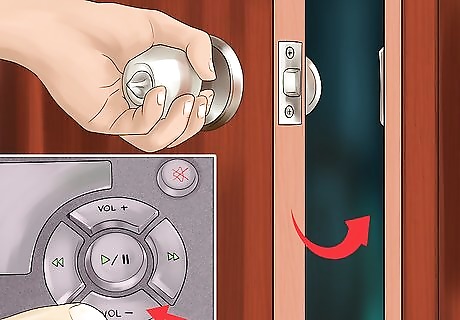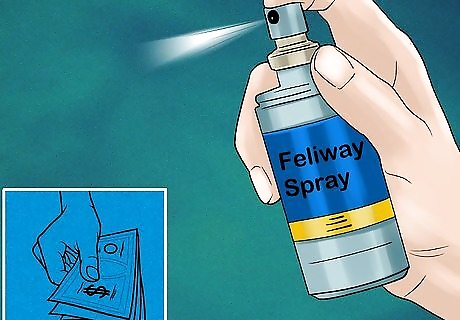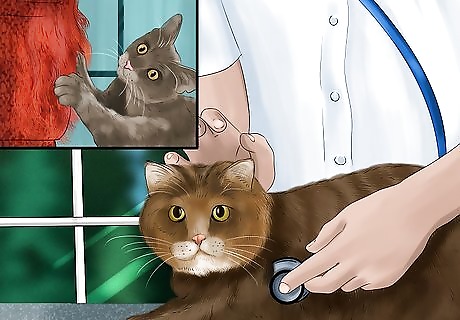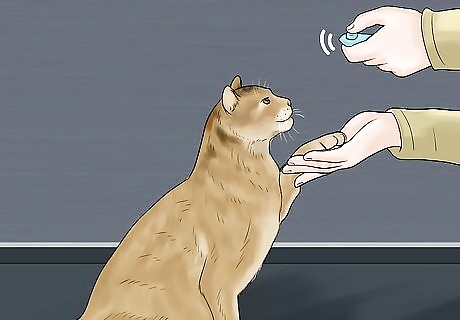
views
Making Changes at Home

Provide a safe spot to hide. Cats like to take cover in confined places for stressful situations. Put a bunch of toys and a favorite blanket in a comfortable hiding spot, like a crate or a closet that your cat can take cover in. A covered hiding spot may make your cat feel more at ease. Try giving it a box or crate in a quiet place with a blanket draped over the top. Try taking a worn t-shirt of yours and put it in the cat's bed or hiding spot. The shirt with your scent may comfort your cat while it is scared.

Drown out bothersome noise. When you know that a certain noise bothers your cat, use other noises to mask the sound. Turn up the music or television. Close doors and windows to try to block out problematic noise. If your cat responds negatively to all loud noise, this strategy could be counterproductive.

Wear your cat out with play. Exercise will tire out your cat and reduce stress levels. Play with your cat daily to reduce its anxiety levels. Consider purchasing a food puzzle, so your cat has something to play with when you aren’t available.

Remain calm during a crisis. It might be hard to restrain yourself from petting your cat and offering emotional support. Providing this support, however, so is a sort of positive reinforcement, which signals to your cat that it should be worried. Instead, act as if nothing is happening.

Give your cat a special toy right before the storm. Your cat probably won’t want to play during the storm, but if you give it the toy shortly before the storm, it will build positive associations with loud noise. Try using a special toy that you know your cat likes, but only gets to play with right before the storm.

Purchase pheromone sprays. Pheromone sprays can be purchased over the counter, without veterinarian approval, and reduce cats’ stress levels. Spray the pheromone in a room that your cat spends most of its time in.
Diagnosing and Treating Severe Phobias

Visit a veterinarian when your cat’s behavior changes suddenly or becomes dangerous. It is normal for loud noises to make your cat anxious, but you should take your cat to the veterinarian if its behavior changes suddenly. If it begins to hurt itself, tries to escape, shows signs of diarrhea, or begins destroying property, you should also take your cat to the veterinarian.

Ask your veterinarian about long-lasting anti-anxiety medications. Some medications, like Amitriptyline, Prozac, and Buspirone, can be administered throughout a long, stressful period, like storm season. It can take 3-4 weeks for these medications to take effect, so they won’t be useful in emergency situations, but can help during prolonged periods of stressful noise.

Ask your veterinarian about medications for emergency situations. There are other medications that are too powerful to administer to your cat on a regular basis, but which you can give to your cat directly before a period of loud noise to calm it down. These include Alprazolam and Valium.
Desensitizing Cats to Noises

Refrain for desensitizing training unless your cat is well trained. Desensitizing training works best when your cat is trained to take commands, which is relatively rare. If your cat cannot take commands, this method is only likely to cause more stress.

Teach your cat the command “relax.” Use a clicker or lure to teach your cat to sit down peacefully next to you. Reward it every time that it responses correctly to the command, until it has mastered the command.

Expose your cat to light noise. Play a recording of a sound that frightens your cat at a very low volume. Command your cat to relax, and reward it with a treat if it remains relaxed. Do not reward it if it fails to follow through. If the cat cannot remain calm, try playing the sound at a lower volume next time. Find a volume that the cat is comfortable with and get it accustomed to the noise.

Increase the volume once your cat has adjusted to the noise. Once the cat has successfully followed the command, increase the volume slightly the next time you practice. Repeat this training exercise at least once a week, progressively increasing the volume.

Practice training in a real life scenario. When an actual storm comes through, command your cat to relax. Reward your cat if it follows through with the command. Do not reward it if it fails to follow the command.




















Comments
0 comment